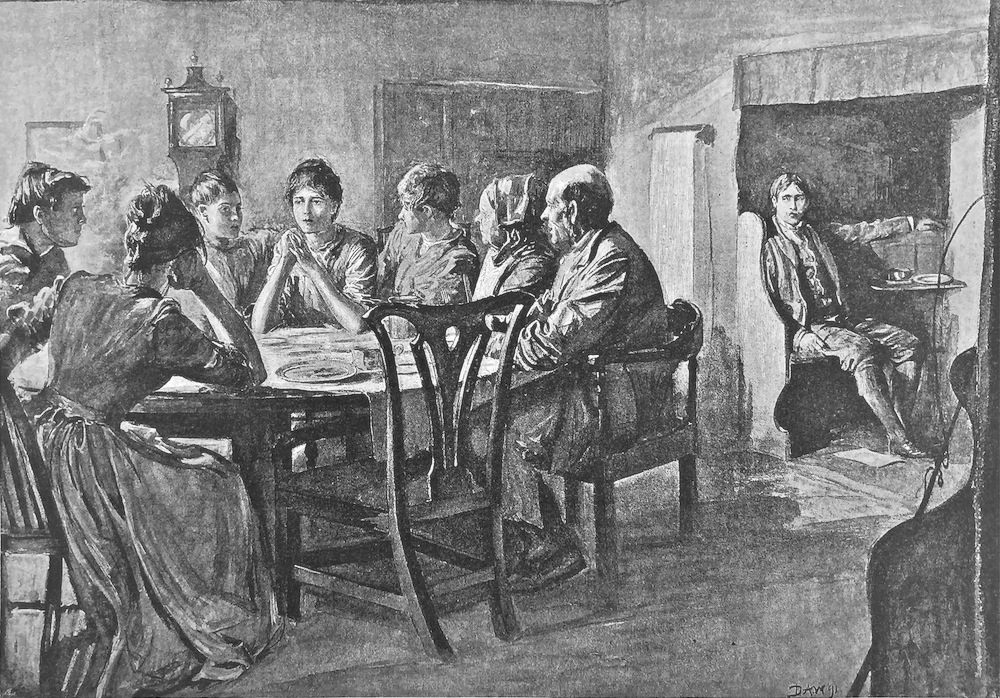
"I don't know about ghosts," she was saying by D. A. Wehrschmidt. Plate 6 from the weekly serialisation of Thomas Hardy's Tess of the Durbervilles, 189: Angel Clare takes note of Tess's voice. Whole-page, horizontal: 30.5 cm high x 21.7 cm wide (12 ⅜ inches by 8 ⅝ inches wide), framed, in the London Graphic (15 August 1891), sixth instalment beginning Book Second, Ch. XV; instalment begins over the page; p. 192; passage realised is at the top of column 2, end of instalment. [Click on image to enlarge it.].
Passage Illustrated: Angel Takes Note of the New Dairy-maid
The conversation at the table mixed in with his phantasmal orchestra till he thought: “What a fluty voice one of those milkmaids has! I suppose it is the new one.”
Clare looked round upon her, seated with the others.
She was not looking towards him. Indeed, owing to his long silence, his presence in the room was almost forgotten.
“I don’t know about ghosts,” she was saying; “but I do know that our souls can be made to go outside our bodies when we are alive.”
The dairyman turned to her with his mouth full, his eyes charged with serious inquiry, and his great knife and fork (breakfasts were breakfasts here) planted erect on the table, like the beginning of a gallows.
“What — really now? And is it so, maidy?” he said.
“A very easy way to feel ’em go,” continued Tess, “is to lie on the grass at night and look straight up at some big bright star; and, by fixing your mind upon it, you will soon find that you are hundreds and hundreds o’ miles away from your body, which you don’t seem to want at all.”
The dairyman removed his hard gaze from Tess, and fixed it on his wife. [Book Second, Chapter XVI, 192; Phase the Third, "The Rally," Chapter XVIII in the 1897 volume edition, 154]
Commentary
Once again, we are are in the constructed or built environment rather the natural world that seems so congenial to Tess. Interior spaces occur in Wehrschmidt's fifth, sixth, and eight plates. Here, in the centre of a group of breakfasters, Tess indulges in metaphysical speculation as Angel overhears the conversation from stage left, "in the yawning chimney-corner" (XVI: 192). The picture has affinities with the quiet interiors of seventeenth-century Dutch genre paintings as, in a detailed domestic interior setting, it graphs relationships and tells a story. The term "detailism" applies well here as Wehrschmidt in the manner of Pieter de Hooch's early interiors uses a careful accumulation of such realia as the empty chair (centre), Crick's carver-chair, and the grandfather clock and dresser in the background to create a three-dimensional, naturally-lit space to emphasize the realism of the moment realised.
The congenial atmosphere implies the harmonious relationship that exists between the young women and their employer, an affable father-figure. The breakfast room is clean, orderly, simple, spacious, and full of morning light. This last detail hardy specifies as streaming in from the far side of the breakfasters: "light from the long, wide, mullioned window opposite shone in upon his nook" (XVI: 192). The artist has ennobled the group by eliminating the pastoral context evident in such workaday elements as the milk-house door in the rear and the leads full of milk beyond; in the quiet, reasonable interior Crick and the milkmaids are not merely Hodges gathered for a meal, but respectably attired, dignified, intellectualized individuals in tableau. In contrast to the philosophical discussion led by Tess, the Graphic supplies a normative context for the lives of agricultural workers in "Rural Notes" concerning the season, the harvest, thunder-storms, and the pedigrees of farm animals (all immediately after this instalment of Hardy's pastoral).
Note: The next five plates are by different illustrators. Please see the full sequence in the complete list of illustrations.
Scanned image and text by Philip V. Allingham. Formatting by George P. Landow. [You may use this image without prior permission for any scholarly or educational purpose as long as you (1) credit the person who scanned the image and (2) link your document to this URL in a web document or cite the Victorian Web in a print one.]
Bibliography
Allingham, Philip V. "The Original Illustrations for Hardy's Tess of the D'Urbervilles Drawn by Daniel A. Wehrschmidt, Ernest Borough-Johnson, and Joseph Sydall for the Graphic (1891)." The Thomas Hardy Year Book, No. 24 (1997): 3-50.
Hardy, Thomas. Tess of the D'Urbervilles in the Graphic, 1891, 4 July-26 December, pp. 11-761.
Jackson, Arlene M. Illustration and the Novels of Thomas Hardy. Totowa, NJ: Rowman and Littlefield, 1981.
Created 5 December 2000
Last modified 9 May 2025